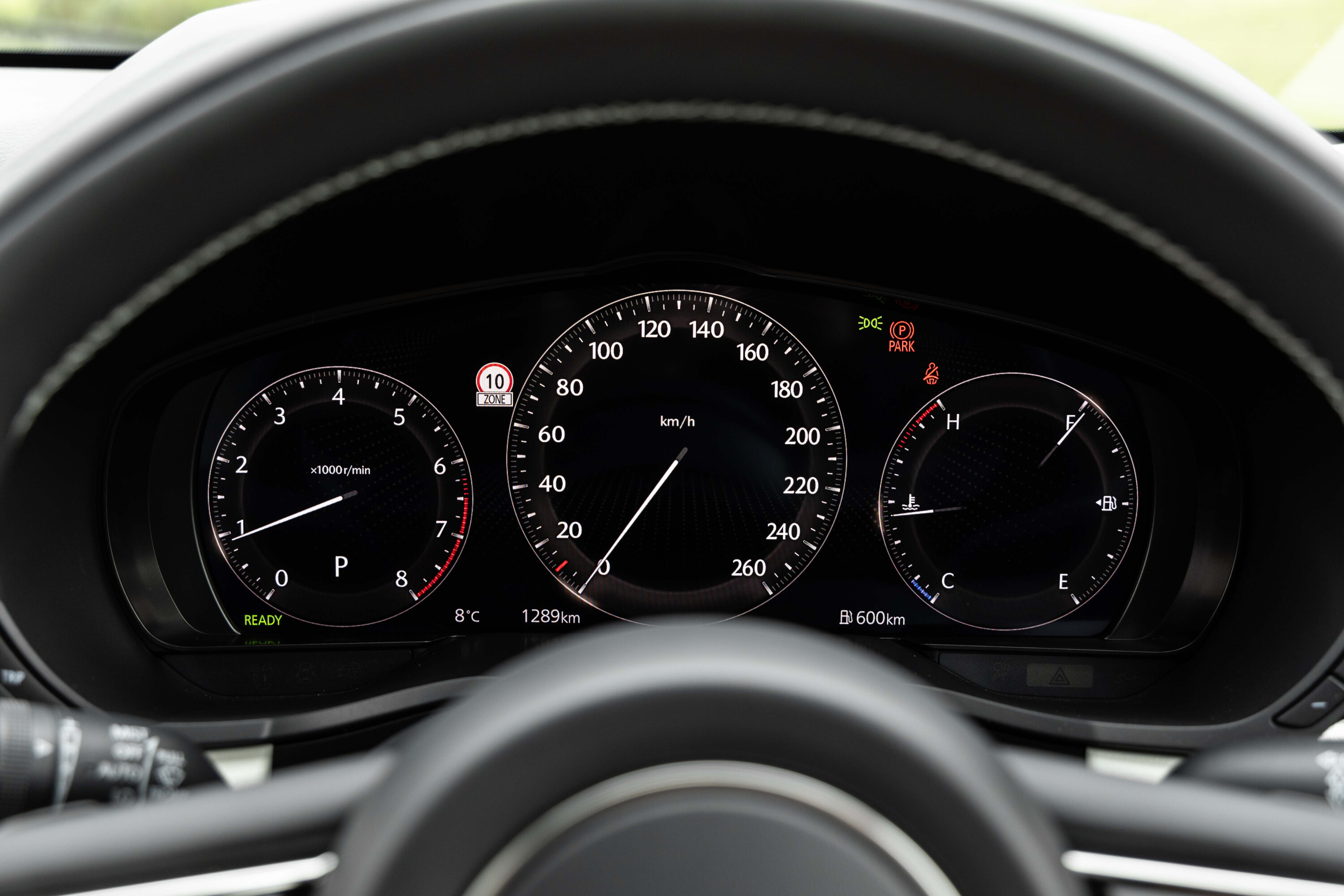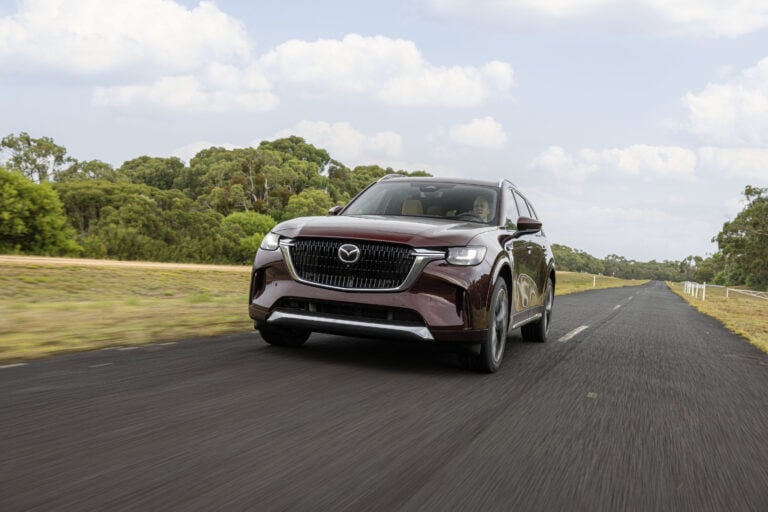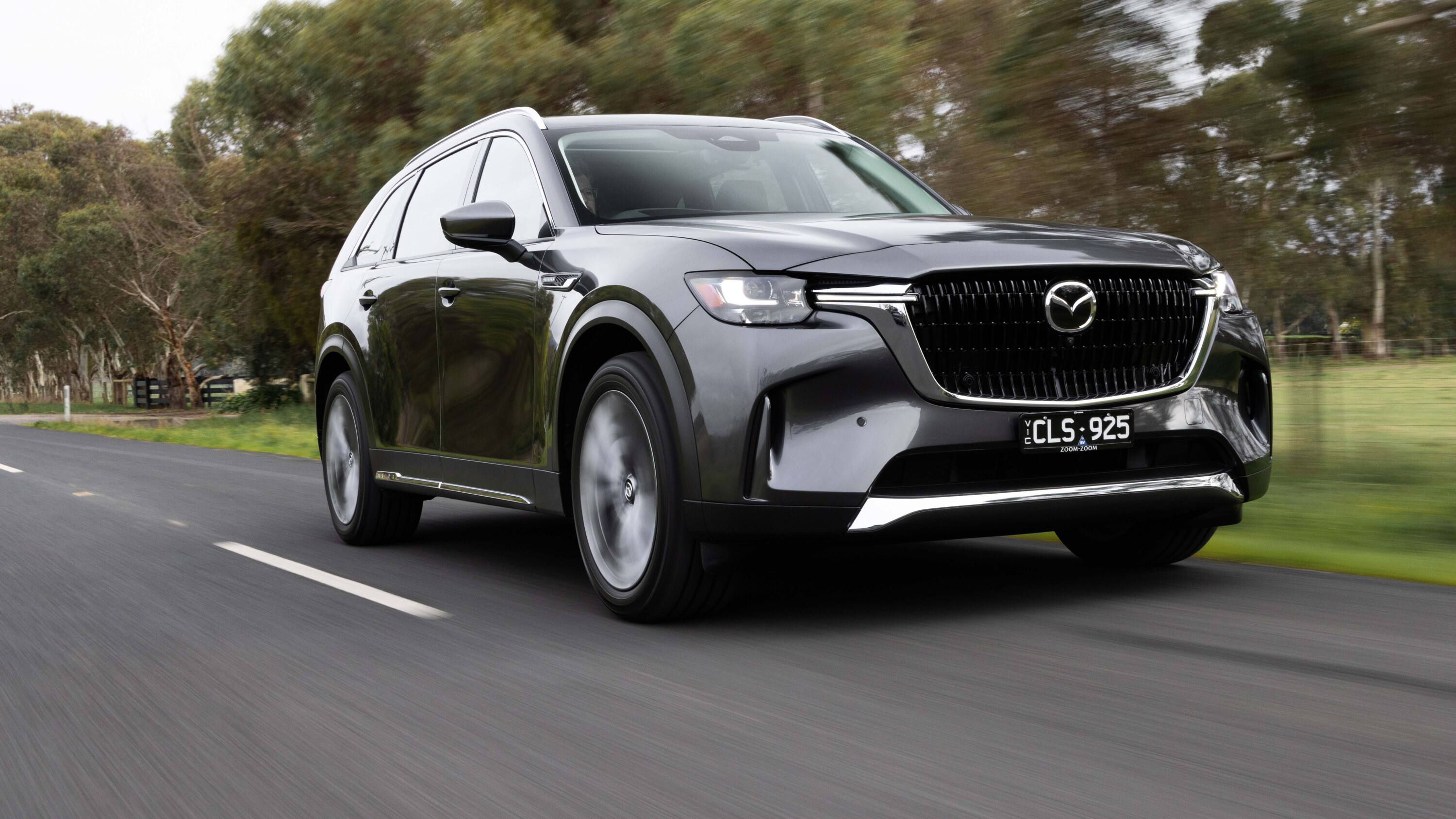Score breakdown
Things we like
- Adept chassis
- Spacious third row
- Huge boot
- Likeable diesel
Not so much
- Substantial weight
- No ‘green’ engine option yet
- Ride comfort and refinement needs to be better
- Interior lacks sparkle unless you spend big
As far as corporate glow-ups go, Mazda’s has been fascinating to watch.
Now deep into the most transformational period in its history, the Japanese automaker’s premium product offensive is in full swing – and the first results of it have charm, glitz and glamorous good looks in abundance.
But our first experience with the CX-60 – the first of Mazda’s all-new (and we mean “all new”) vehicles to utilise its freshly-minted longitudinally-engined Large Product platform – produced mixed emotions.
On the one hand, it rewards keen drivers through its powertrain and chassis talent, but a brittle ride and poor refinement means the rest of the driving population arguably won’t be as impressed.
And now, less than a month after the Australian launch of the CX-60, we have its bigger sister the CX-90 to consider.
Taking the same architecture as the -60 and stretching it longer and wider, the CX-90 is a hulking 5.1-metre long three-row family bus that makes the CX-60 look like a Mazda 3 and even puts the CX-9 (which is due to be retired soon) in its shadow.
Its pricing is just as imposing – at least, for regular Mazda customers – but the company is convinced the CX-90 offers value for money despite being its first model to breach the six-figure barrier since the FD RX-7.
RELATED VIDEO
JUMP AHEAD
- How much is it, and what do you get?
- Interior comfort, space and storage
- What is it like to drive?
- How much fuel does it use?
- How safe is it?
- VERDICT
- Specifications
How much is the CX-90, and what do you get?
The CX-90 range is comprised of ten distinct variants.
There are three trim grades with two powertrain choices for each, with two high-feature option packages available on the top grade that bring a six-seat configuration with individual captain’s chairs in the second row instead of the standard seven-seat layout.
At the bottom of the range is the CX-90 Touring, priced at $73,800 with the G50e 3.3-litre six-cylinder petrol engine, or $75,800 for the D50e 3.3-litre diesel six-pot.
In the middle sits the CX-90 GT grade, which curiously has the petrol and diesel much closer in price at $84,555 and $84,800 respectively, while range-topping Azami spec flips the pricing logic and has the petrol priced above the diesel at $93,655 (opting for a diesel Azami will only cost you $92,540).

Standard equipment levels are healthy, though the base Touring’s 7-inch digi-dash lacks the visual appeal of the 12-3-inch instrument panel of the upper grades.
Azami buyers can also tick the box for one of two $6500 option packages – the SP Pack or Takumi Pack – which bring higher-grade interior finishes (white leather upholstery, Maple wood veneers and attractive “Kakenui” cloth trim for the Takumi Pack, tan nappa leather upholstery and a suede dash trim for the SP Pack) as well as the aforementioned six-seat config that gives the CX-90’s cabin a substantially more upmarket ambience. Doing so pushes the petrol CX-90 Azami’s retail price above the $100K mark.
Standard equipment levels are healthy, though the base Touring’s 7-inch digi-dash lacks the visual appeal of the 12.3-inch instrument panel of the upper grades.

You gain the ability to prod the display when using Android Auto or Apple CarPlay, but only when the car is stopped and in park
The Touring is also only equipped with a 10.25-inch infotainment display instead of the 12.3-incher of the GT and Azami, however no matter the size of screen occupants must contend with Mazda’s clunky infotainment UI, which forces the use of the console-mounted rotary controller despite having touchscreen functionality.
You gain the ability to prod the display when using Android Auto or Apple CarPlay, but only when the car is stopped and in park – and even then it occasionally refuses to recognise your fingertips. Frustrating.
Standard equipment
| 2023 Mazda CX-90 standard features | |
|---|---|
| 10.25-inch infotainment screen on Touring, 12.3-inch screen on GT and Azami | Wireless phone charger |
| Integrated sat-nav | DAB+ radio tuner, 8-speaker audio (12-speaker BOSE on GT/Azami) |
| Head-up display | Wireless Android Auto and Apple Carplay |
| Front and rear parking sensors | Powered tailgate with hands-free activation |
| 360-degree parking camera | Self-dimming rear view mirror |
| Leather upholstery | 19-inch alloy wheels on Touring, 21-inch alloys on GT/Azami |
| Heated and power-adjustable front seats | 6x USB-C charge ports (2x front, 4x rear) |
| Tri-zone climate control with rear zone controls in second row | 150W household power outlet |
| Retractable rear door sunshades | LED headlamps with auto high-beam |

Interior comfort, space and storage
It’s hard to avoid comparisons with the CX-60’s interior, because forward of the B-pillar the CX-90’s cabin furniture looks virtually identical to that of its smaller sibling. That’s both good and bad.
Good, because the CX-60’s cabin has a high-end presentation that’s worth emulating – especially so when paired with the finer upholstery and attractive trim of the expensive Takumi and SP packages. Bad, because the CX-90 is $14-20K more expensive than the CX-60 yet the view from the driver’s seat isn’t all that different.
The CX-90 also inherits the same foibles of the CX-60 as a result, such as unpleasantly hard lower dash plastics, shallow storage bins, a digital dash that makes little use of its flexibility, and poor utilisation of the centre console’s substantial horizontal real estate.

But size matters in the world of SUVs, and the greatest dimensional differentials between the CX-60 and the CX-90 are found in the back of the cabin.
While the CX-60 is strictly a two-row thing, the CX-90 boasts three commodious rows of seats that can swallow up to seven adults – not five adults and two kids, but seven full-grown humans – and still accommodate a couple of large suitcases behind them. This, then, is what you’re really paying for.
The second row has enough cabin width to take three adults across the bench, with identical shoulder room and legroom stats compared to the CX-9 (but 42mm less headroom). The individual second-row captain’s chairs of the Takumi and SP pack are a pleasing dash of luxe too, with comfy cushioning and a useful centre console armrest/storage unit fixed between them.

Getting in and out is also aided by large rear doors that open to nearly 90 degrees, something that greatly facilitates clambering into the third row.
Unfurl each third-row seat by pulling on a strap, and a nicely-padded leather-bound chair is revealed. I’m not especially tall at 175cm, but sitting in the rear seat and clicking the second row backrest into position nevertheless affords me with enough airspace around my legs to be comfortable, and more sprawling room than what’s found in a CX-9.
My feet are naturally a little more crowded by the seat’s base, but sliding the second row a few centimetres forward vastly improves that situation without trimming too much comfort from your fellow passengers.

Headroom is also generous back there, and the big quarter-glass and elevated seat base provide a great view to the front and sides.
There are even USB-C power outlets, dedicated air vents and four(!) cupholders for those in the rearmost seats. It’s refreshing to see a family-sized SUV where the third row isn’t a penalty box.
When the third row is stowed the CX-90’s boot offers up a 608-litre load space that’s substantially wider and deeper than the CX-60’s 477L capacity, yet even with all seats raised the CX-90 still provides a 257L cargo capacity.
That’s 59 litres more than the CX-9 offers in the same configuration, and a difference that can be chalked up to the CX-90’s greater cabin length and rear overhang.

| Mazda’s family SUVs by size | |||||
|---|---|---|---|---|---|
| Model | CX-5 | CX-8 | CX-60 | CX-9 | CX-90 |
| Wheelbase | 2700mm | 2930mm | 2870mm | 2930mm | 3119mm |
| Length | 4550mm | 4900mm | 4740mm | 5075mm | 5120mm |
| Width | 1840mm | 1840mm | 1890mm | 1969mm | 1994mm |
| Height | 1660mm | 1730mm | 1670mm | 1747mm | 1745mm |
| Boot (5 seats up) | 438L | 775L | 477L | 810L | 1155L |
| Boot (7 seats up) | 5 seats only | 209L | 5 seats only | 230L | 451L |
What is the CX-90 like to drive?
As with the CX-60, the CX-90’s all-new platform, straight-six engines, transmissions and suspension design hold great promise – particularly as Mazda identified the adoption of a longitudinally-engined architecture as being mission-critical for its push into the realm of “premium”.
Alas, the execution falls short. Like the CX-60, the CX-90 suffers from ride quality qualms, excessive sound intrusion from its mechanicals, and a transmission that could use a trip to finishing school.
When judged in isolation it’s by no means awful, but at this lofty price bracket it’s not unreasonable to expect better. After all, for the vast majority of buyers the concept of “premium” isn’t tied to which direction the crankshaft points.

There’s also no escaping the CX-90’s considerable mass – at 2.2 tonnes without passengers or cargo, it’s a beast.
The suspension does its best to contain that heft and dynamically the CX-90 steers rather well, but hitting a big compression puts more energy into the undercarriage than the suspension can handle, often making the body pogo for a couple of cycles rather than smoothly dissipating that energy through a single rebound stroke.
If you had the impression that the suspension is simply too soft from that sentence, then you’d be wrong: on smaller-amplitude bumps, the CX-90 transmits too much into the cabin rather than just steamrolling over the small stuff – which is what you’d expect a 2250kg SUV on 21-inch wheels to do.

“Premium” cars should feel plush over choppy urban roads but taut on everything else, but the CX-90’s suspension is the diametric opposite.
Note: we didn’t get the opportunity to drive on the base model Touring’s standard 19-inch wheels and its taller-sidewall rubber, only the bigger 21’s of the GT and Azami.
And then there’s the prominent gearbox whine when accelerating, as well as shift harshness that appears when doing light-throttle, light-brake transitions in low-speed traffic crawls. The eight-speed transmission is another in-house Mazda creation and it works great when driven hard, but again it’s the ordinary day-to-day conditions that reveal its rough edges.
Which is truly a shame, because the core engineering appears to be really good – it’s just the tuning that lets it down.

The suspension does its best to contain the heft, and dynamically the CX-90 steers rather well
There’s the sense that there wasn’t enough time to polish the calibration before production specs had to be locked-in, which sucks because those downsides overshadow the positives – namely the lovely interior and exceptionally smooth 3.3-litre petrol and diesel inline-sixes.
Speaking of which, the diesel is a peach. Making 187kW and 550Nm, the latter available from as low as 1500rpm, the diesel presents as an ideal long-distance cruiser. It’s just a pity that its tow rating is just 2000kg rather than the petrol’s 2500kg, thanks to a less capable cooling package.
The CX-90’s petrol six is significant for being Mazda’s most powerful production engine to date, its 254kW power output and 500Nm torque figure providing plenty of brag-factor.
It’s just a shame that the car’s weight soaks up most of that mumbo, leaving performance that’s definitely swift… but not any more scintillating than what you find in the CX-60.
If any of the terms in this section have left you scratching your head, these articles will help bring you up to speed!

- What is a Powertrain or Drivetrain?
- Power vs torque
- Car suspension explained
- Automatic transmissions (‘gearboxes’) explained
- Chassis control systems explained
- Car vs Ute vs SUV: How the vehicle you buy should guide the way you drive
Launch events are typically terrible for assessing fuel economy, and the 10.6L/100km and 7.0L/100km averages we saw for the petrol and diesel respectively were predictably higher than the factory claims of 8.2L/100km and 5.4L/100km.
It’s also worth noting that the petrol needs to be fuelled with 95RON premium unleaded, though that’s the norm for modern turbo petrol engines.
Both six-cylinder engines are mild hybrids, with the ability to coast with the engine-off and (barely) sustain their forward momentum using their electric motor/generator.
A proper hybrid would help slake thirst further, but one isn’t available at launch – it’s coming next year in the form of the CX-90 plug-in hybrid with a 241kW/500Nm 2.5-litre non-turbo petrol/electric setup.

How safe is the CX-90?
The CX-90 has yet to be rated by ANCAP.
However its standard safety equipment includes a suite of 10 airbags (including curtain bags that cover the third row), frontal collision warning, AEB with pedestrian/cyclist detection and reversing mode, blind spot monitoring, driver fatigue monitoring, lane-keep assist, frontal and rear cross traffic alert, front and rear parking sensors and a 360-degree camera view.

VERDICT
In a great many ways, the CX-90 feels very much like a scaled-up CX-60 with an extra row of seats – from their design to the way they drive, they’re awfully close together.
That’s no huge surprise given how much they share under the skin, but for buyers prepared to spend big money on a Mazda SUV and are cross-shopping the CX-60 and the CX-90, the absence of substantial differentiation – both visual and otherwise – may be a turn-off. In that scenario, the third-row and capacious boot are the only true value-adds.

It compares well against European rivals on a price-per-feature basis, but the bigger issue is how unfinished the CX-90 feels.
As Mazda’s flagship model – and one that commands a six-figure asking price – it’s not unreasonable to demand excellence, however the CX-90 stops short of that mark.
Its problems aren’t unsolvable, mind you, but there’s a nagging sense that the CX-90 was pulled out of the oven before it was completely ready.
RELATED VIDEO
2023 MAZDA CX-90 SPECIFICATIONS
| Mazda CX-90 G50e Azami w/Takumi package (LHD) | |
|---|---|
| Price | $100,185 + on-road costs |
| DRIVETRAIN | |
| Engine | inline 6-cyl, 3.3-litre, dohc turbo-petrol |
| Layout | front engine, longitudinal, AWD |
| Power | 254kW @ 5000-6000rpm |
| Torque | 500Nm @ 2000-4500rpm |
| Transmission | 8-speed automatic with wet clutch |
| CHASSIS | |
| L/W/H/Wu2013B | 5120/1994/1745/3119mm |
| Track (F/R) | 1704/1707mm |
| Weight (claimed USA) | 2222kg |
| Boot (SAE) | 451/1155/2130L |
| Fuel/tank | 95 RON / 74L |
| Economy (combined ADR 81/02) | 8.2L/100km |
| Suspension | Front: double wishbone Rear: multi-link independent |
| Steering | rack-assisted electric power steering 3.25 turns lock to lock |
| Front brakes | 347mm ventilated rotors |
| Rear brakes | 350mm ventilated rotors |
| Tyres | Yokohama Advan V105 |
| Tyre size | 275/45R21 |
| SAFETY | |
| ANCAP rating | not yet tested |
| 0-100km/h (claimed) | 6.9 seconds |
Score breakdown
Things we like
- Adept chassis
- Spacious third row
- Huge boot
- Likeable diesel
Not so much
- Substantial weight
- No ‘green’ engine option yet
- Ride comfort and refinement needs to be better
- Interior lacks sparkle unless you spend big
We recommend
-
 News
News2023 Mazda CX-90 pricing and features
The all-new CX-90 large SUV is the second-most-expensive Mazda ever sold in Australia, as it pushes the brand into Q7-rivalling territory
-
 Reviews
ReviewsVIDEO: 2024 Mazda CX-90 review – Australian first preview drive
First spin of six-pot SUV proves CX-90 is a triumph for Mazda’s premium philosophy – but is the timing right?
-
 News
NewsNew car calendar 2026: All the new cars coming to Australia next year
Here’s the WhichCar by Wheels guide to all the new cars that will launch in Australia in 2026. Check back in regularly for updates...





